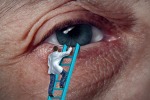

Vision loss has become a major health issue for seniors. 30% of Americans, age 65 and older suffer from  vision problems that can’t be corrected with contact lenses or glasses. The American Foundation for the Blind reports the prediction is that this number will double by the year 2030.
vision problems that can’t be corrected with contact lenses or glasses. The American Foundation for the Blind reports the prediction is that this number will double by the year 2030.
Losing your vision can severely impact the quality of your life. Aside from hindering basic activities such as reading or watching TV, losing your vision can impact your mobility and freedom. Visually impaired seniors are also at a much higher risk for falls and fractures. Many seniors may experience depression as a result of their vision problems, and the resulting limitations in their lives.
Age-related vision problems are usually caused by one of these four major conditions: cataracts, diabetic retinopathy, macular degeneration and glaucoma.
Cataracts
Cataracts occur when too much protein builds up in your eye lens, resulting in a clouding of your vision. Over half of all Americans age 65 and older have cataracts, and it is the number one cause of blindness worldwide. Some of its symptoms include: vision that seems cloudy, blurry or foggy, double vision, perceiving colors differently and problems with glare and halos around lights.
In the United States, cataract surgery, which is readily available and effective, has reduced the blinding effect of cataracts. It is usually recommended to those who have cataracts that impact their everyday activities.
You can also take preventative measures in order to lower your chances of getting cataracts. A study reported by the National Center of Biotechnology Information showed that those eating a diet rich in antioxidant vitamins, such as vitamins A, C and E, had a smaller risk of developing cataracts.
Diabetic Retinopathy
Diabetic Retinopathy causes the blood vessels in your eyes to swell and leak fluid. In some cases is causes new blood vessels to grow on the surface of your retina. Although it may seem unnoticeable at first, diabetic retinopathy worsens with time and can eventually lead to vision loss.
Some of its symptoms include: vision loss, blurry vision, fluctuating vision, empty or dark areas in your vision and spots or floaters in your vision. These symptoms tend to appear as the disease progresses, as the early stages of diabetic retinopathy appear relatively symptom and pain free.
Prevention of this condition is very important. Control of your blood sugar levels, blood cholesterol and blood pressure can prevent the development or the progression of diabetic retinopathy. If you have diabetes, it is recommended that you get blood tests regularly to measure A1C levels and blood lipid levels. This is usually recommended every three months. It is also important to get regular comprehensive eye exams in order to check for early signs of the disease. Once it’s entered the later stage, known also as proliferative retinopathy, a procedure known as scatter laser treatment is used to shrink the abnormal blood vessels.
Age-Related Macular Degeneration (AMD)
AMD is the leading cause of vision loss for people ages 50 and older. It affects the macula, which is the part of the eye that helps you see the fine detail in things. There are two different types of AMD: wet and dry.
Some symptoms include: diminished or changed color perception, dark, blurry areas, white out in the center of vision, straight lines becoming distorted
Luckily macular degeneration is preventable. Here are some steps you can take to prevent AMD:
Glaucoma
Glaucoma is a condition that damages your eye’s optic nerve through a buildup of pressure inside the eye. It tends to be a hereditary disease that doesn’t show up until later in life. Just like diabetic retinopathy, there are no early symptoms. Once it develops and progresses, you may have experience some of the following symptoms:
You can decrease your risk for glaucoma by leading a healthy lifestyle. Keep your blood pressure at healthy levels, so there isn’t increased pressure in your eyes. Keep your insulin levels regulated by avoiding sugars and unrefined grains, and eat a nutrient rich diet. Exercise regularly and take a multivitamin.
If you are diagnosed with glaucoma, a doctor may recommend prescription eye drops. Surgery to reduce the pressure within the eye is a possible treatment for more advanced cases.
Although age-related vision loss is quite prevalent, in many cases it can be prevented. Call your doctor today if you are experiencing any of the above symptoms, or think that you may be at risk for vision loss.
Author: Kimberly Recor, staff writer at Designing Brighter Tomorrows
© 2014 Designing Brighter Tomorrows, Inc.
This site is for information only, and is for your voluntary use at your own risk. See Terms of Use